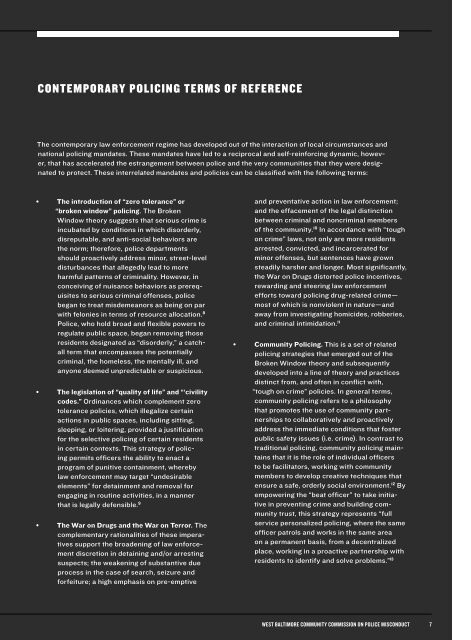OVER-POLICED YET UNDERSERVED POLICE MISCONDUCT IN WEST BALTIMORE
No-Boundaries-Layout-Web-1
No-Boundaries-Layout-Web-1
Create successful ePaper yourself
Turn your PDF publications into a flip-book with our unique Google optimized e-Paper software.
CONTEMPORARY POLIC<strong>IN</strong>G TERMS OF REFERENCE<br />
The contemporary law enforcement regime has developed out of the interaction of local circumstances and<br />
national policing mandates. These mandates have led to a reciprocal and self-reinforcing dynamic, however,<br />
that has accelerated the estrangement between police and the very communities that they were designated<br />
to protect. These interrelated mandates and policies can be classified with the following terms:<br />
• The introduction of “zero tolerance” or<br />
“broken window” policing. The Broken<br />
Window theory suggests that serious crime is<br />
incubated by conditions in which disorderly,<br />
disreputable, and anti-social behaviors are<br />
the norm; therefore, police departments<br />
should proactively address minor, street-level<br />
disturbances that allegedly lead to more<br />
harmful patterns of criminality. However, in<br />
conceiving of nuisance behaviors as prerequisites<br />
to serious criminal offenses, police<br />
began to treat misdemeanors as being on par<br />
with felonies in terms of resource allocation. 8<br />
Police, who hold broad and flexible powers to<br />
regulate public space, began removing those<br />
residents designated as “disorderly,” a catchall<br />
term that encompasses the potentially<br />
criminal, the homeless, the mentally ill, and<br />
anyone deemed unpredictable or suspicious.<br />
• The legislation of “quality of life” and “‘civility<br />
codes.” Ordinances which complement zero<br />
tolerance policies, which illegalize certain<br />
actions in public spaces, including sitting,<br />
sleeping, or loitering, provided a justification<br />
for the selective policing of certain residents<br />
in certain contexts. This strategy of policing<br />
permits officers the ability to enact a<br />
program of punitive containment, whereby<br />
law enforcement may target “undesirable<br />
elements” for detainment and removal for<br />
engaging in routine activities, in a manner<br />
that is legally defensible. 9<br />
• The War on Drugs and the War on Terror. The<br />
complementary rationalities of these imperatives<br />
support the broadening of law enforcement<br />
discretion in detaining and/or arresting<br />
suspects; the weakening of substantive due<br />
process in the case of search, seizure and<br />
forfeiture; a high emphasis on pre-emptive<br />
and preventative action in law enforcement;<br />
and the effacement of the legal distinction<br />
between criminal and noncriminal members<br />
of the community. 10 In accordance with “tough<br />
on crime” laws, not only are more residents<br />
arrested, convicted, and incarcerated for<br />
minor offenses, but sentences have grown<br />
steadily harsher and longer. Most significantly,<br />
the War on Drugs distorted police incentives,<br />
rewarding and steering law enforcement<br />
efforts toward policing drug-related crime—<br />
most of which is nonviolent in nature—and<br />
away from investigating homicides, robberies,<br />
and criminal intimidation. 11<br />
• Community Policing. This is a set of related<br />
policing strategies that emerged out of the<br />
Broken Window theory and subsequently<br />
developed into a line of theory and practices<br />
distinct from, and often in conflict with,<br />
“tough on crime” policies. In general terms,<br />
community policing refers to a philosophy<br />
that promotes the use of community partnerships<br />
to collaboratively and proactively<br />
address the immediate conditions that foster<br />
public safety issues (i.e. crime). In contrast to<br />
traditional policing, community policing maintains<br />
that it is the role of individual officers<br />
to be facilitators, working with community<br />
members to develop creative techniques that<br />
ensure a safe, orderly social environment. 12 By<br />
empowering the “beat officer” to take initiative<br />
in preventing crime and building community<br />
trust, this strategy represents “full<br />
service personalized policing, where the same<br />
officer patrols and works in the same area<br />
on a permanent basis, from a decentralized<br />
place, working in a proactive partnership with<br />
residents to identify and solve problems.” 13<br />
<strong>WEST</strong> <strong>BALTIMORE</strong> COMMUNITY COMMISSION ON <strong>POLICE</strong> <strong>MISCONDUCT</strong> 7


